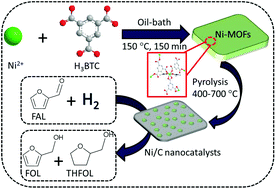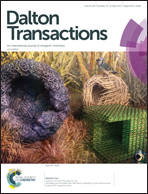Carbon-embedded Ni nanocatalysts derived from MOFs by a sacrificial template method for efficient hydrogenation of furfural to tetrahydrofurfuryl alcohol†
Abstract
We report a fast and simple method for the synthesis of Ni-based metal–organic-frameworks (Ni-MOFs). Due to the existence of nickel ions and an organic ligand, the MOFs are employed as a sacrificial template for the facile preparation of carbon-embedded Ni (Ni/C) catalysts by a direct thermal decomposition method. The obtained Ni/C catalysts exhibit excellent catalytic activity for selectively transforming furfural (FAL) to tetrahydrofurfuryl alcohol (THFOL) due to the Ni nanoparticles (NPs) embedded uniformly in the ligand-derived carbon. The exemplified results illustrate that the catalytic performance of the Ni/C catalyst is greatly affected by the calcination conditions (temperature and time), composition of the Ni-MOF precursor and the catalysis conditions. The conversion of FAL and selectivity of THFOL both reached 100% under the conditions of 120 °C, 1 MPa H2 pressure and 120 min of hydrogenation over the Ni/C-500 catalyst, derived from the pyrolysis of Ni-MOFs (Ni : BTC mole ratio of 1.0) at 500 °C for 120 min, which exhibits an average nanoparticle size of ∼14 nm and uniform dispersion, and the highest BET surface area (∼92 m2 g−1) among all investigated Ni/C catalysts. This facilely prepared heterogeneous catalyst would be very promising for the replacement of noble metal catalysts for the efficient catalytic conversion of biomass-derived feedstocks into value-added chemicals.



 Please wait while we load your content...
Please wait while we load your content...